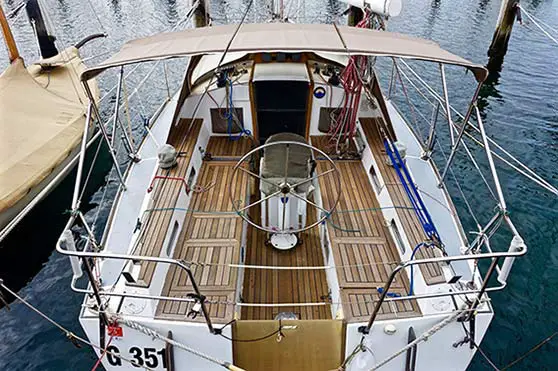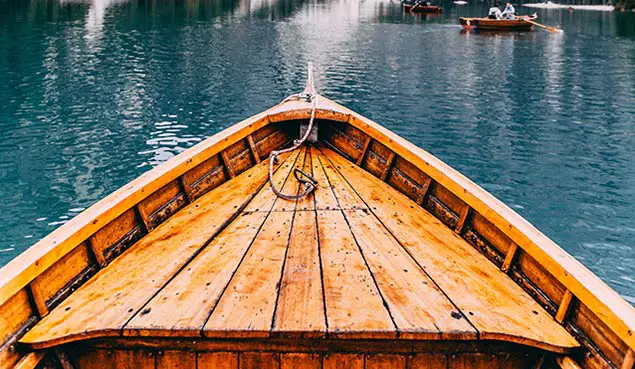When you think about sailing and sailboat maintenance, few people would stop to give much attention to the cabin sole. Thousands of pages of instructions have been written about how to repair your engine or tune your rig, but very little has been written about the floor of the cabin.
Despite the fact that it receives very little attention in the boating community, the cabin sole is actually a lot more important than you might think. After all, nobody wants to step into the cabin and end up standing in the bilge!
In this article, we are going to explore some of the most common issues that sailors experience with their cabin soles, and how to repair or replace the cabin sole after it has incurred damage. To learn everything that you need to know about the care, maintenance, and repair of sailboat cabin soles, keep reading!
Contents
What is a Cabin Sole and What Materials are Used to Build Them?
The cabin sole is the floor that you stand on in the cabin of a sailboat. The sole typically rests on floorboards that separate the bilge from the main cabin interior.
Depending on the make of your boat, a variety of materials can be used to construct the cabin sole. Below, we will review some of the most popular types of materials that are used to build a cabin sole.
Fiberglass
In many smaller and cheaper cruising sailboats, the cabin sole is built from the same fiberglass used to construct the hull and the deck.
When used to build the cabin sole, the fiberglass is often “cored”, which means that there are two layers of fiberglass foam or wood in the center to stiffen the material without the extra weight and cost of solid fiberglass.
Most sailboats with a fiberglass cabin sole have one or more removable access ports to inspect the bilge below. To make the cabin more inviting, many sailors cover the fiberglass sole with a rug or small carpet.
Plywood with veneer
This is one of the most common materials that is used to build the cabin sole on commercially produced sailboats. With this type of construction, the cabin sole is built primarily from plywood, with a small layer of hardwood veneer to give it a professional look.
Plywood with veneer-style cabin soles can look almost identical to solid hardwood if they have been professionally built. But after long periods of exposure to water, the veneer can peel off, leaving the plywood exposed to potential rot.
If your vessel has this type of cabin sole, make sure to check regularly for any delamination or moisture getting into the plywood, as this can cause serious problems later on.
Solid teak or holly
This is by far the best type of cabin sole for a cruising sailboat. If it’s properly built, a solid teak or holly cabin sole should last longer than both the boat and its owner!

The only disadvantage is the high cost and difficulty to obtain the materials, as hardwoods become harder to buy.
Bamboo
If you are looking for a middle path between solid teak and a veneer-style cabin sole, bamboo may be the perfect alternative.
Bamboo cabin soles have just recently hit the market, but they have very positive reviews so far. Bamboo is much cheaper to obtain than teak and it’s fast-growing, so it’s easier on the environment too!
What Damage Can Occur to Your Cabin Sole Over Time?
Due to its position at the bottom of the boat, the cabin sole is exposed to damage from two sources.
First, there is the damage from above – wear and tear from walking, gear being dropped or water spilling on top of the cabin sole. But the most common source of damage is from below.
Since the bilge sits just below the cabin sole, water in the bilge can cause the cabin sole to accumulate moisture and rot over time. That’s why it’s so important to try to keep your bilges dry as often as possible and to regularly check your cabin sole for rot or other water damage.
How to Fix Damage to Your Cabin Sole
So what to do when your cabin sole is showing signs of wear and tear? The remedy to repair the damage depends entirely upon how extensive the problem is.
Sometimes the surface of the cabin sole starts to fade over time. When this happens, it’s often possible to simply apply teak oil to the faded areas, which can restore minor faded areas back to their original shine.
If your cabin sole is made with veneer and it’s beginning to peel off, then it will take a little more work to get it back in top shape.
First, peel off the veneer on the damaged areas and check the plywood to confirm that there is no rot or moisture in the wood below. If the plywood is totally intact, you may choose to simply replace the veneer with a new layer. When the plywood is damaged, it’s time to think about replacing the entire cabin sole.
With hardwood cabin soles, it’s unlikely that you will need to make extensive repairs unless it has been exposed to a large amount of water for a long period of time.
Sometimes the wood may develop black spots which can be removed by sanding until the discolored area is removed and re-varnishing the exposed wood. If there are small areas with rot, you can cut out the damaged wood and a small portion of the surrounding wood and replace it with new hardwood.
For fiberglass soles, it may be possible to repair small sections by cutting out the damaged areas and applying layers of new fiberglass and epoxy over the damaged section.
How to Replace Your Cabin Sole
If the damage to the cabin sole is extensive, it’s possible that you may have to replace the entire sole with new material. This can be quite a daunting task, especially on larger vessels, so it’s recommended to hire a professional shipwright to get it done right if you aren’t experienced with boatbuilding.
The challenge with replacing the cabin sole is cutting the wood to fit all the curves and irregular surfaces on a boat. If you decide to do it yourself, here are the steps to replacing your cabin sole:
- Completely remove the old cabin sole from the boat. As you do this, try not to damage the hull or any structure that supports the integrity of the boat. If you can, keep the old cabin sole as intact as possible to use as a template for the new sole.
- Make sure that all of the stringers or frames that support the sole are intact. The new sole will depend on them to be able to support any serious weight.
- Select and purchase the material that you will use to build the new sole. Make sure that it’s compatible with a marine environment, and confirm that you have enough material for the build.
- Cut the new sole to fit the floor of your cabin. The easiest way to do this is to use the old sole as a pattern.
- Fit the new sole in place and make sure that it fits perfectly. Make adjustments as necessary to get the ideal shape.
- Secure the new flooring to the supports underneath. Most boaters will screw the sole in place, using wooden bungs to cover up the screws.
- If the material is not pre-finished, sand and varnish the sole until it has the desired appearance you want for your boat.
Cabin Sole Maintenance to Avoid Future Issues
In order to avoid having to replace your cabin sole or make regular repairs, there are some simple steps you can take to keep your cabin sole in good condition. Below are some easy things you can do to maintain a beautiful and functional cabin sole.
- Keep the bilge dry! The number one source of water damage and rot in a cabin sole is water from the bilge. Install an automatic bilge pump, and sponge up any remaining water to keep the bilge and cabin sole dry at all times.
- Try to minimize the amount of humidity inside the cabin by providing adequate ventilation (and heat, if you keep your boat in a wet and cold climate).
- Do everything you can to prevent water from entering the cabin via an open hatch, window, vent, or the companionway. If water does find its way below and ends up on the cabin sole, mop it up as soon as possible.
- Check the cabin sole (both above and below, if you have an access port to the bilge) for moisture at least two or three times per week. If you find water, follow it to the source and eliminate the cause of the leak, like the marine toilet leak.
- Cover areas with heavy foot traffic with a non-slip rug or carpet to avoid excessive wear and tear to the surface of the cabin sole. Make sure that the rug is secure, so that it won’t cause your crew to slip and fall.
- Secure any heavy gear that could fall onto the cabin sole in heavy seas to prevent damage to your floors.
- Wipe down the entire surface of the cabin sole with teak oil at least once per month and clean it regularly with wood soap to maintain the shine.
Summary
With proper care and maintenance, you can expect your cabin sole to last for a long time.
Of the different types of material used to build cabin soles, plywood with veneer is most prone to water damage.
For those who can afford it, a hardwood sole that is properly installed and maintained can be in great shape for many decades!
No matter what type of cabin sole you have in your boat, the most important thing is to keep it dry!
If you can avoid water damage and keep the sole from getting broken by loose objects in the cabin, chances are you will have a beautiful and functional cabin floor for years to come.







